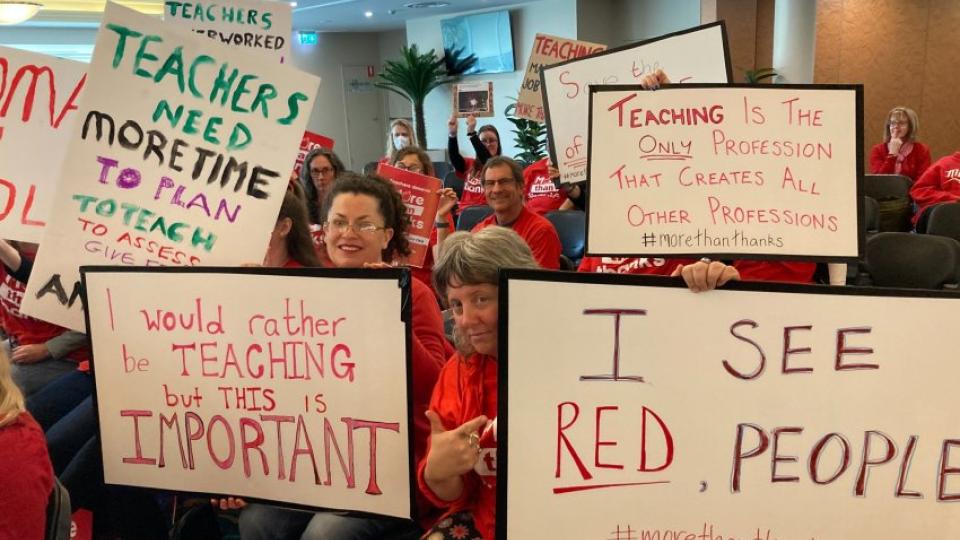What must be done to save public education

The world-renowned educator Professor Pasi Sahlberg has observed that the root causes of Australia’s teacher shortages are unproductive working conditions and non-competitive pay.
“Workload is the most common reason for intending to leave the teaching profession,” he said, citing a recent Monash University survey in which teachers reported it was difficult to fit their workloads into a reasonable working week.
[block:views=node_blocks-related]
“This is due to overwhelming administration, reporting and paperwork for compliance purposes,” Sahlberg said.
Two surveys of education staff in Victoria confirm this. Conducted in 2016 and 2021, they found that, on average, teachers work 53 hours per week, principals 58 hours and education support staff work 43 hours a week, although many may be part time.
Either way, they all reported that they never have enough time to complete all the work they need to do. The work week is supposed to be 38 hours.
The unsustainable working conditions have caused a “big burnout” across the country, the surveys found. This has led to a critical teacher shortage.
The situation is dire in rural, regional and remote areas and in science, mathematics, special/inclusive education, languages, technology and applied studies.
Federal education minister Jason Clare admitted the problem is a national one. State education ministers agreed.
The Victorian Secondary Teachers Association's 1986 agreement said that face-to-face teaching would not exceed 18 hours a week. Currently, secondary teachers must work 20 hours of face-to-face teaching each week.
Larger classes — meaning more preparation and corrections — more meetings and many more administrative tasks are exacerbating this burn-out.
More face-to-face teaching means less time for innovative planning. A tired teacher does not have the mental energy to create imaginative lessons. There is less time for collaborative work, yet learning the sharing of ideas leads to innovation.
Without adequate support for the complex needs of some students, they become alienated from learning. Teachers must spend a lot of time and energy engaging with these students who can also be verbally or physically abusive. This takes a toll on teachers’ mental health and energy levels.
I would return home crying nearly every day in my first year of teaching and then stay up until midnight preparing lessons. This is a still a familiar story for new teachers.
Class management challenges and workload pressures lead to many graduate teachers leaving the profession after just five years.
Modelling from the Education Department in August found that the demand for teachers in the next few years will far exceed those wishing to teach. Just 50% of student teachers graduate, far lower than students of other degrees (average of 70%).
Clare’s proposals after the meeting of state education ministers on August 12 will do little to solve the crisis. Paying so-called “highly accomplished teachers”, also known as performance pay, has already been rejected by the profession. It means that only a small proportion would receive a good pay rise: principals and education support staff would receive nothing.
Teaching is a collective and collaborative effort: when my colleagues take over my classes next year, they build on my year’s work. Which teacher should be rewarded?
Moreover, classes are dynamic and students develop and change over time. A student who was disengaged in year 8 may, in year 10, have a totally different attitude.
It is not down to the “shortcomings” of the year 8 teacher or the “accomplishments” of the year 10 one: it may be the hard work of both, or factors external to the classroom.
Pitting some teachers against others is a cheap alternative to giving all teachers a fair pay rise.
As Sahlberg said, performance-based pay can lead to “declining creativity and collegiality in schools”, especially when test scores like NAPLAN become the dominant driver of teachers’ work.
Clare is also promoting a High Achieving Teachers Program, to be run by Teach for Australia (TFA), a private organisation which is largely funded by the federal government.
TFA recruits graduates while they are still studying, ostensibly for disadvantaged and regional schools. The program has recorded a high failure rate, with only about 50% still teaching after three years.
Clare has also suggested lowering the barriers to recruit teachers from overseas. While there should be no restrictions on migrants or employing foreign teachers, it must not be a pathway for keeping wages low or ignoring the critical question of workload.
There are thousands of qualified people who would return to teaching if the pay and conditions were up to scratch.
Clare and his state counterparts have repeatedly said that pay rises are not the only problem and that workload hours also need to be addressed. He did not say how, perhaps because it requires a big injection of federal and state funding.
For better learning, class sizes must be reduced from 30 or more students to a maximum of 20 students, ideally smaller. Schools need more rooms to accommodate more classes.
Face-to-face hours need to be reduced to, at most, 18 hours for both primary and secondary teachers. This would also mean more teachers are employed.
Resources and support for students with behavioural and learning difficulties must be given a big boost. Special schools need many more teachers and teacher assistants.
These measures require a lot more investment in education, something Clare and state education ministers pointedly refused to promise.
[Mary Merkenich has been a public school teacher for 38 years. She is member of Socialist Alliance.]